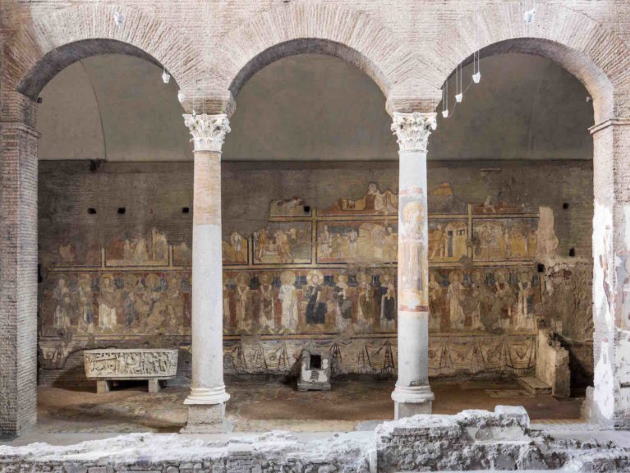
Ein verstecktes Juwel, das im Jahr 1900 ans Licht kam: die Kirche Santa Maria Antiqua an den Hängen des Palatin ist das wichtigste und älteste christliche Bauwerk auf dem Forum Romanum. Sie wurde Mitte des 6. Jahrhunderts auf den Strukturen eines großen architektonischen Komplexes aus der Zeit Domitians errichtet und bewahrt an ihren Wänden eine Fülle von Gemälden, die sie zu einem wahren „Museum“ der römischen Malerei in der Zeit machen, als der Einfluss von Byzanz auf Rom am größten war. Während des Erdbebens von 847 wurde die Kirche unter Schutt begraben und anschließend verlassen. Im 13. Jahrhundert entstand aus ihrer Asche eine neue Kirche, die Santa Maria Liberatrice geweiht war. 1617 wurde sie von Onorio Longhi im Barockstil wiederaufgebaut und schließlich 1899 abgerissen, um die ursprüngliche Kirche „wiederherzustellen“.
Das Innere besteht aus drei Schiffen mit zwei kleinen Kapellen auf beiden Seiten des Presbyteriums. Etwa 250 Quadratmeter Fresken aus dem 6. bis 9. Jahrhundert sind noch sichtbar. An der Dekoration wurden zahlreiche Eingriffe vorgenommen. Davon zeugt die so genannte „Palimpsest“-Wand rechts von der Apsis. Hier lassen sich sechs Malereischichten erkennen, die während der Lebensdauer der Kirche entstanden sind. Das Bild der thronenden Madonna mit dem Kind in byzantinischer Kleidung stammt aus der ersten Phase der Kirche; aus dem 7. Jahrhundert stammt die Verkündigung mit dem so genannten „Schönen Engel“. Besonders gut erhalten ist der dem Martyrium der Heiligen Quirico und Giulitta gewidmete Zyklus, der fast vollständig die Theodotuskapelle schmückt und aus dem Pontifikat von Papst Zacharias (741-752) stammt. Die Kapelle auf der rechten Seite des Presbyteriums ist hingegen den Heiligen der Medizin gewidmet. Im linken Seitenschiff ist eine Theorie der Heiligen der griechischen und lateinischen Kirche dargestellt, mit Christus in der Mitte, der von Geschichten aus dem Alten Testament überragt wird.
Neben dem Eingang der Kirche befindet sich das Oratorium der Vierzig Märtyrer, das über einem anderen Raum aus römischer Zeit errichtet wurde, der möglicherweise der Eingang zur Domitian-Rampe war, die zu den Kaiserpalästen auf dem Palatin führte. Der Name leitet sich von dem Gemälde aus dem 8. Jahrhundert ab, das die Apsis schmückt und auf dem die Hingabe von 40 christlichen Soldaten gepriesen wird, die während der Verfolgung durch Diokletian zum Tod im eisigen Wasser eines Sees in Armenien, in Sebaste, verurteilt waren. Das Oratorium hat einen viereckigen Grundriss und beherbergt noch ein Fresko des Heiligen Antonius des Einsiedlers an der rechten Wand und einen Fußboden aus Marmorfragmenten aus dem Mittelalter.
Informationen
1-26 March and 1-29 October > 9.30-16.45 (last admission at 16.15)27 March - 30 September> 9.30-18.30 (last admission at 18)30 October - 28 February > 9.30-15.45 (last admission at 15.15)
 Condividi
Condividi
Location
Um mehr über alle barrierefreien Dienste zu erfahren, besuchen Sie den Abschnitt barrierefreies Rom.











































